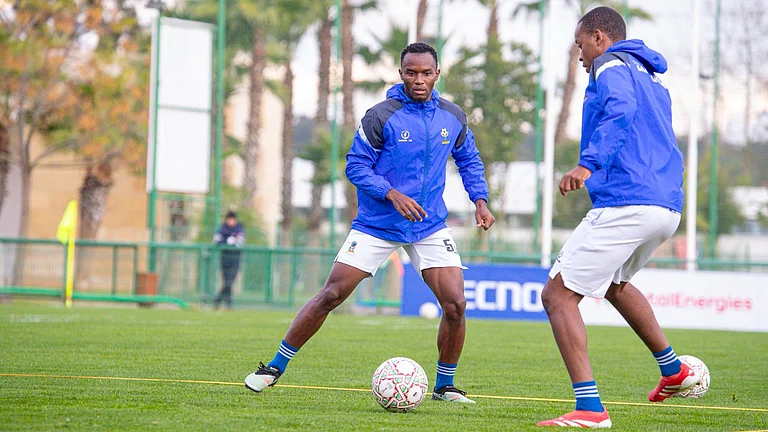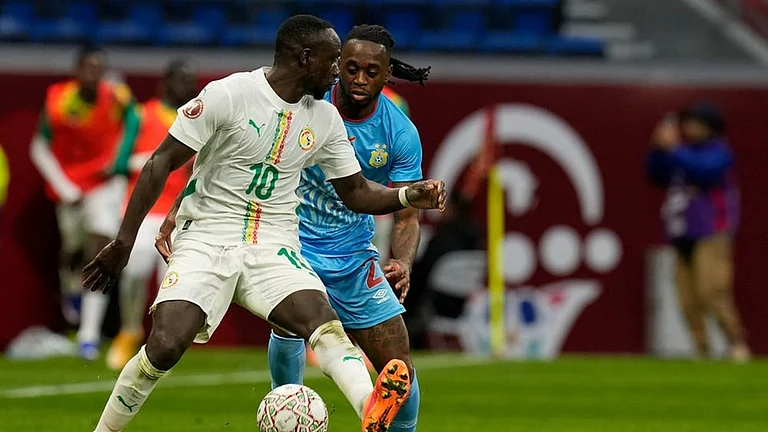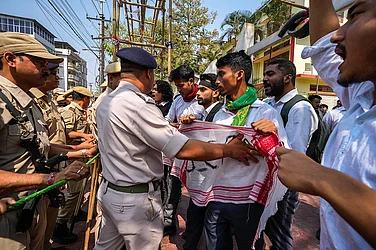A tweet and a political feat—between these two separate events in a week’s span appeared some cracks that Karnataka’s ruling Congress has struggled to paper over. The first was a loud complaint about the selection of candidates, not uncommon in election season, and yet surprising because it came as a tweet by senior Congress leader M. Veerappa Moily’s son. The second event, certainly more politically significant and risky, was Chief Minister Siddaramaiah’s decisive move to recognise the large and powerful Lingayat community as a religious minority.
In the run-up to Monday’s announcement on Lingayats, there was enough rumbling to suggest the Congress was in a tricky position. The key issue—one that has been debated endlessly over the past year—was whether the Lingayats and Veerashaivas, who form a significant section of the state’s electorate, were to be seen as distinct from each other after long years of a synonymous coexistence. While pressure mounted from religious seers arrayed on both sides of the argument, there were indications that prominent Lingayat ministers in Siddaramaiah’s cabinet like M.B. Patil, S.S. Mallikarjun, Vinay Kulkarni and Eshwar Khandre too stood divided on the issue.
“No, they are not divided; the decision was unanimous,” Karnataka law minister T.B. Jayachandra told Outlook after a cabinet meeting that went on for close to three hours. It took time, he explains, because there were long discussions and all ministers were individually asked for their opinion. “Of course, there were some people advocating for Veerashaivas to be included. So we have said Veerashaivas can also be a part of the Lingayat community.” In essence, the government appears to have sidestepped the contentious notion of splitting the community by including Veerashaivas within the definition, while also leaving it to the Centre to ultimately ratify the decision.
While the BJP’s senior leaders were quick to label it as an attempt by the Congress to divide Hindus, the response from the community’s religious leaders was mixed. Some Veerashaiva seers accused the government of trying to divide the community for political reasons.

Lingayats and Veerashaivas clash after the minority status announcement
To put it in a snapshot, when the government puts out a notification, the Lingayat faith would become the seventh religious minority group that Karnataka recognises along with Muslims, Christians, Sikhs, Buddhists, Jains and Parsis. For the record, however, it was in Maharashtra, home to about 1.2 crore Lingayats, that such a move was contemplated first. “Maharashtra had done it in 2014, but before they could send it to the government of India, the elections were announced and so it remained there,” says S.M. Jaamdar, a retired Karnataka IAS officer who is part of the Lingayat Swatantra Dharma Vedike, a forum that has been demanding the minority status.
According to Jaamdar, the impact in Karnataka would be mostly in education because Lingayats run numerous institutions from schools to professional colleges. “That’s why the Lingayat community is highly literate today,” he says. “But that was not percolating to the poorer sections of the community. Now, under minority status, they can reserve up to 50 per cent of the seats for Lingayats and poorer sections will be able to get cheaper access.”
The Lingayats comprise nearly 99 sub-castes, some of them eligible for reservation as backward classes in the state. “In no way will minority status affect the quotas,” says an expert. “Almost all religious minorities in Karnataka are in the backward classes list.”
Like most people who argue in favour of the minority tag, Jaamdar says it would eventually end the “hegemonic control” of the community by Veerashaivas, who also hold on to tenets of Hinduism such as Vedic rituals, besides Basava’s philosophy. On that note, the debate as we know it now, draws back to several hundred years of cultural history.
“The demand to recognise the Lingayat faith as a religion is not new. The government has only recognised a fact acknowledged as far back as the Mysore Census of 1871,” went Siddaramaiah’s reply to the BJP’s accusations. The response from the BJP’s state president B.S. Yediyurappa, a Lingayat himself, was more guarded. “We have decided that the BJP will stand by the decision taken by the Akhila Bharata Veerashaiva Mahasabha. Now that the state government has sent its recommendations, I urge the Mahasabha to study the same and guide the society,” he said. Here’s where the Lingayat issue doesn’t lend itself to an easy analysis because many of the Mahasabha’s top office-bearers are also Congressmen, like the veteran leader Shamanur Shivashankarappa.
For the moment, at least, Siddaramaiah appears to have survived the threat of a rift among his cabinet colleagues over the Lingayat issue. But then there’s that other tricky issue, wholly unrelated, over selecting candidates for the assembly polls flagged by the controversial tweet of Moily’s son Harsha. Though Harsha distanced himself from the tweet, which seemingly attacked the state’s PWD minister, H.C. Mahadevappa, over “money in politics”, the Karnataka Congress nevertheless issued him a showcause notice. But, by then, the controversial tweet had already triggered discussion over the contest for party tickets. Besides, there’s also speculation that the sons of several leaders, including Siddaramaiah’s son Yathindra, are hoping to stand for elections.
Last month, many Congress partymen were frowning over some lateral entrants into the party, especially Ashok Kheny from Bidar and Anand Singh from Bellary, both of whom the Congress has attacked in the past on various charges. “There is some restlessness about taking people into the party without much consultation,” says a Congress leader on the newly inducted members. “These things have worried workers a little bit.” Of course, fissures within the Congress aren’t anything new. But they had been somewhat subdued over the past couple of years with Siddaramaiah, whom many party leaders looked upon as an outsider, partly making him neutral vis-a-vis old rifts.
Some skirmishes, in a party like Congress, are inevitable, says political commentator Sandeep Shastri. Of course, it happens elsewhere too. The BJP, for instance, had a long bout of infighting among its state leaders before the central leadership stepped in to get things into shape.
“The biggest challenge the Congress is going to face is how to ensure that internal fissures in the party don’t damage its prospects,” says Shastri. “Right from the 1990s, if anything has really damaged the Congress prospects, it was the contradictions within.”
By Ajay Sukumaran in Bangalore


























